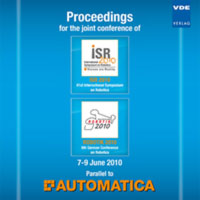UMTS One Way Delay Characterization for Mobile Robot Teleoperation
Conference: ISR/ROBOTIK 2010 - ISR 2010 (41st International Symposium on Robotics) and ROBOTIK 2010 (6th German Conference on Robotics)
06/07/2010 - 06/09/2010 at Munich, Germany
Proceedings: ISR/ROBOTIK 2010
Pages: 8Language: englishTyp: PDF
Personal VDE Members are entitled to a 10% discount on this title
Authors:
Zeiger, Florian; Kempf, Florian (Zentrum für Telematik e. V., Allesgrundweg 12, 97218 Gerbrunn, Germany)
Schilling, Klaus (Universität Würzburg, Lehrstuhl Robotik und Telematik, Am Hubland, 97074 Würzburg, Germany)
Abstract:
In the meantime, the Universal Mobile Telecommunications System (UMTS) has reached an expansion stage which allows for using this communication technology in the area of networked robotics and for the teleoperation of mobile robots. The support of mobility, the availability of wireless communication, and the provided bandwidth are typical major criterion for the evaluation of a communication technology in robotics scenarios. Nevertheless, mobile robot teleoperation has different requirements on the communication channel based on the setup of the scenario and the task definition. Many applications also require additional knowledge of the one way delay of the communication channel in order to allow for a seamless integration of the telerobotic system. With respect to availability, mobility, and the supported bandwidth UMTS is already analyzed and telecommunication providers give detailed information. By contrast, information on the expected one way delays in such systems are given only rarely and not as comprehensive as required for real implementations of telerobotic systems. This work gives a detailed analysis of the one way delay characteristics of the communication channel for different application scenarios of mobile robot teleoperation via UMTS. The distribution of one way delays are evaluated for different setups and for different data stream characteristics which are typical in the area of networked robotics. Also the measurement setup is described in detail and an approach for measuring one way delays is presented which allows for measurements of the required resolution by using standard equipment.


